Dock Fouling. Also known, as lying on your belly, on bird poop covered docks in an attempt to find marine invertebrates, sponges, and hopefully nudibranchs!
While nature enthusiasts love the community of organisms that establishes on docs, boats and unattended structures, boat owners not so much, and this is where the term originated. When barnacles, sponges, algae etc. grow on a boat haul, it increases the boat’s weight and therefore slows it down, essentially “fouling” it. The growth fouls the boat’s bottom. Hence the term dock fouling!
Since docks generally stay put, they provide a great landing pad for lying face down to view what’s below and on the sides. Docks could be harbor boat ramps, marina docks, any sort of floating dock-like structure with marine communities growing along the vertical edge just below water line and within reach of your fingers.
You are probably imagining something that looks quite odd, and it is, just see the photos above. A person lying on a dock with their head draped over a dock, hands in the water. Weird! Yes, and stares, looks, and questions from anyone passing by is essentially guaranteed. I warned you. But anyone that’s curious enough to ask us what we are looking at find it interesting, and cool, because duhhhh it is!
Dock Fouling is where we found a Candelabrum fremani, which you can read all about it here.
This past weekend my hubs and I went all in and went dock foulding all weekend long, here are our observations and some interesting tidbits on each species.
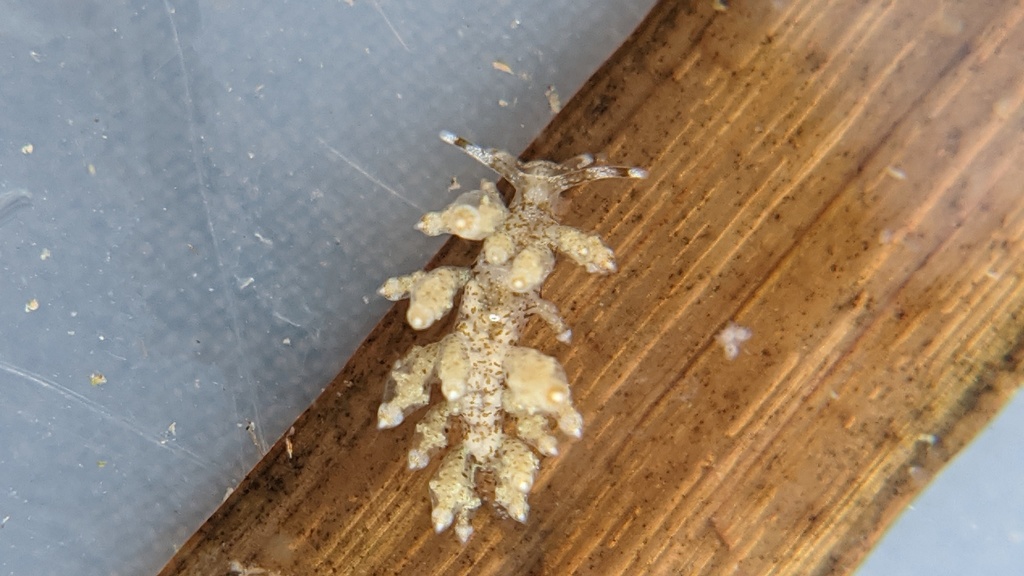
Homely Aeolid 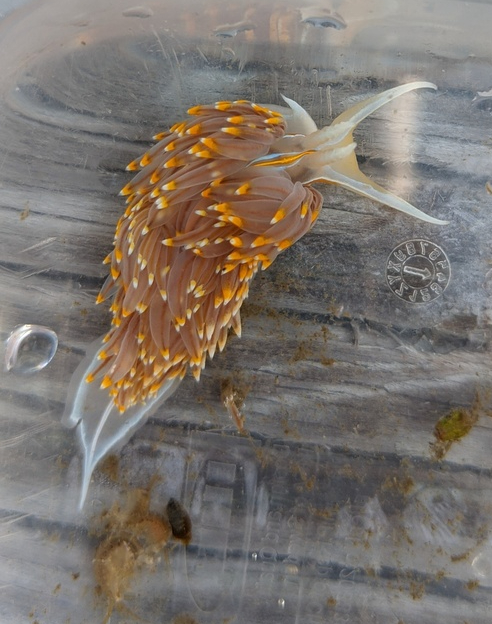
Opalescent Nudibranch 
Los Angeles Okenia 
Hedgpeth’s Dorid 
Orange-spike Polycera
Mr. Homely Aeolid feeds on two types of hydroids, Obelia as well as Plumularia. Couldn’t find much otherwise, but always a lovely find.
Opalescent Nudis locally are like the pigeons or crows of downtown city streets. Abundant and beautiful, I can’t complain. But this dude was huge compared to most I’ve seen, coming in at three to four inches long. The long orange tip projections are called cerrata. This is where the nematocysts are stored, which they accumulate through eating hydroids or anemones and then use as a defense mechanism. Opalescents need these structures as apparently they are aggressive little dudes, and engage in biting battles! Yikes!
The Los Angeles Okenia was a lifer for us this weekend, yipee! They eat bryozoans of the Amathia or Bowerbankia, and San Francisco Bay is its northernmost point of its range.
Upon googling for Hedgpeth’s Dorid to learn more, I’ve never gotten so many results for obituaries for a person and not the actual species. Doris Hedgpeth, hope you had a great life. RIP Doris. Sadly this nudibranch is not native to California.
The Orange-spike Polycera are hermaphrodites, like other nudibranchs. Male actors are determined by the victor of a penis fight, whoever stabs the other first, “wins.”
The featured photo on this post is a Branched Dendronotus, Dendronotus venustus.
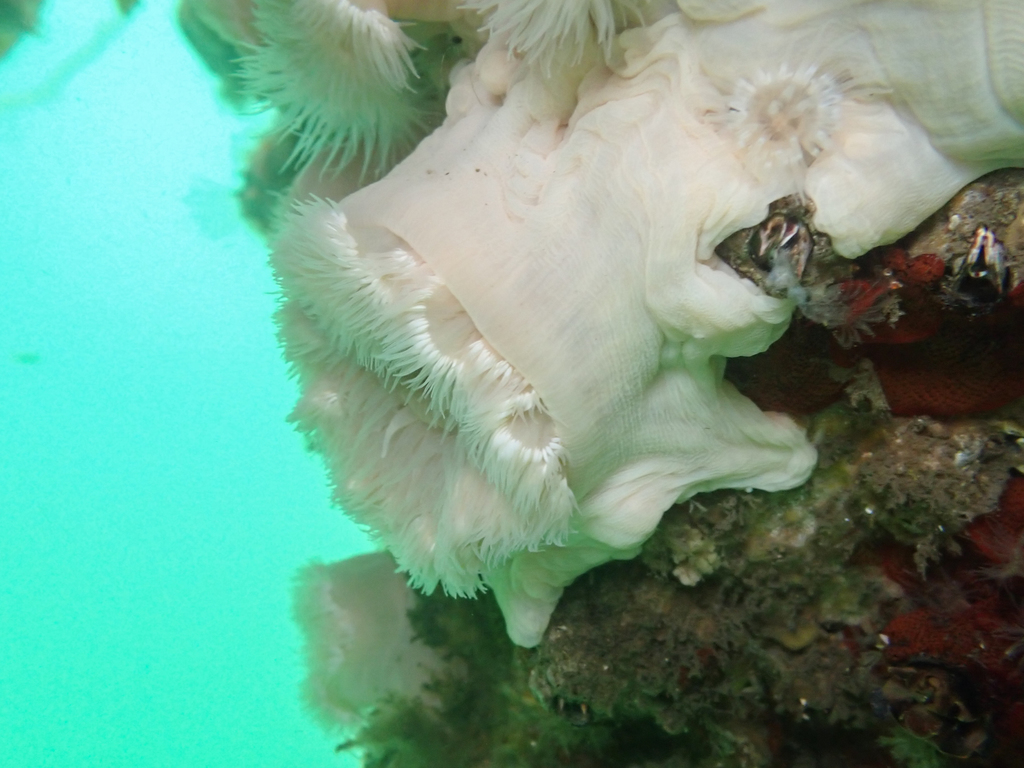
Plumose Anemone 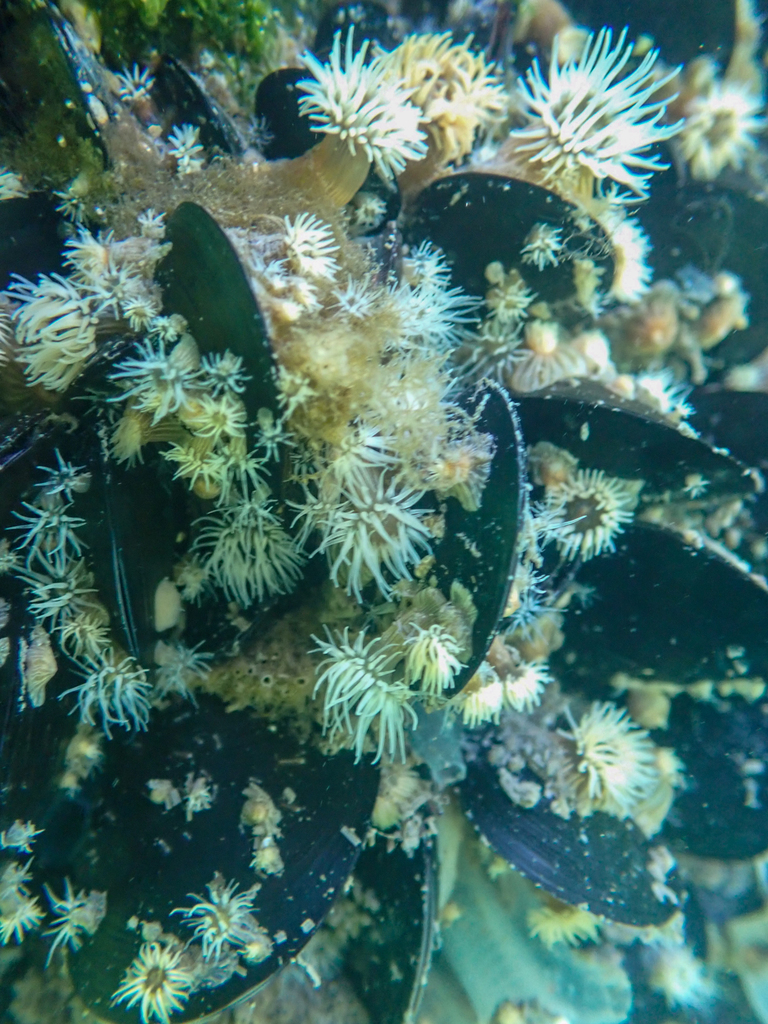
Diadumene 
Sunburst Anemone 
Strawberry Anenome
These plumouse anemone were big, fluffy, and numerous! Beautiful! Plumose totaly makes sense as a name, as their any branched tentacles almost make them look fluffy, soft, and caresable, like a big feather boa.
Not much information exists on the Genus Diadumene, or all the way up to Superfamily. So here’s a fun fact on Order Actiniaria (Sea Anemones), some are asexual, others breed sexually, and some both!
Sunburst Anemone’s get their name by a their radiating lines protruding from the oral disc, of which you can’t see in the photo above, sorry! But I love a name that reflects a physical characteristic. While it has defensive techniques against predators using their stinging tentacles, I often forget these guys can and will detach from their substrate and say “tootle loo,” hopefully landing in a safer spot.
Oooooo yummy. A wall of strawberry anemones, so gorgeous and scrumptious looking! If you are thinking the tentacles look a little different, it’s because it’s true! Their tentacles end with knob/club/bulb like structures which do not entirely retract, interesting!
While many fish species live in Tidepools, and I most often see small sculpins, these two were special appearances for this past weekend.



Cabezon Scorpaenichthys marmoratus
The Cabezon, is one of the species that while common I hadn’t yet seen myself. Finally! It’s genus which it’s the only member of translates to ” scorpion fish.” This beauty is actually a large sculpin, which can reach up to 3ft 3 inches/ 99 cm in length which means weighing up to 11kg/25 lbs. Wooza! This large mouthed bug-eyed creature while scary looking, has a wide variety of colors and patterns/mottling allow it to camouflage just splendidly!

Bay Pipefish 
Bay Pipefish in our small “deli” sized containor
The Bay Pipefish is one of those well known, commonly seen species that has eluded me for so long. We all have those species, be it birds, plants, or tidepool fishes that evade you and when you finally fid it, its such a great relief. At first glance it’s impossible to ignore its super slender body. The green/brown coloration mimics a piece of eel grass, native to it’s habitat along the Eastern Pacific. But why the name pipefish? It apparently comes from the similarity to the skinny smoking pipes popular in the mid 1700s. While it may be obvious to some, it is indeed a member of the family which contains seahorses. So yes, the male pipefish nurtures the eggs the female lays in their specialized brood pouch.
While any new species/lifer or uniquely beautiful observation is special there were two extra special finds this past weekend. One a funny looking polychaete worm, and the other a locally famous nudibranch.
The Lake Merritt Cuthona inhabits, you might have guessed it, Lake Merritt, which is smack dab in the middle of Oakland, CA. My partner and I looked for these guys a year ago, and didn’t find any. Before heading to the docks this time around he said they hadn’t been seen for six years. I didn’t believe them because on iNat they had been seen within the last year, except I saw that it was found in India. So after a six year hiatus we re-found TWO!
I’ve heard and read conflicting arguments saying they originated in Lake Merritt, and others say they were hitchhikers in ballast water, and are in fact non-native to the Bay, perhaps naive to Brazil. Mystery!




The second, and final critter was this, Amblyosyllis nigrolineata. The species name, nigrolineata, means what it sounds like when pronounced slowly: black, and lined. Shallow, intertidal water is this crazy creatures’s preferred habitat, all over the Pacific Ocean, even though on iNat it’s only been seen six times, and only in California.
Good luck dock fouling everyone! Tag me on iNat what you find!
- Dock Fouling iNaturalist Projects:
- Resources / What I read:
- The Mariner’s Guide to Oceanography, Sponsored by The New York Aquarium
- The Living Dock Worksheet from Port Royal Sound Foundation
- Cabezon Wiki Page
- California Marine Sportfish Identification, California Dept of Fish and Wildlife
- Bay pipefish article, Monterey Bay Aquarium
- Bay pipefish Wiki Page
- Plumose Anemone (Metridium spp.) Slater Museum of Natural History, Uni of Puget Sound
- Strawberry Anemone, Oceanscape Network
- Strawberry Anemone, The Dallas World Aquarium
- Homely Aeolid, Wiki Page
- Opalescent Nudibranch, Monterey Bay Aquarium
- Los Angeles Okenia, iNaturalist Page
- Okenia angelenis, Wiki Page
- Polycera hedgpethi, Wiki Page
- Polycera atra, Sealife Base
- Amblyosyllis nigrolineata taxon details, WORMS
- Cuthona perca, Lake Merritt Cuthona, NEMESIS
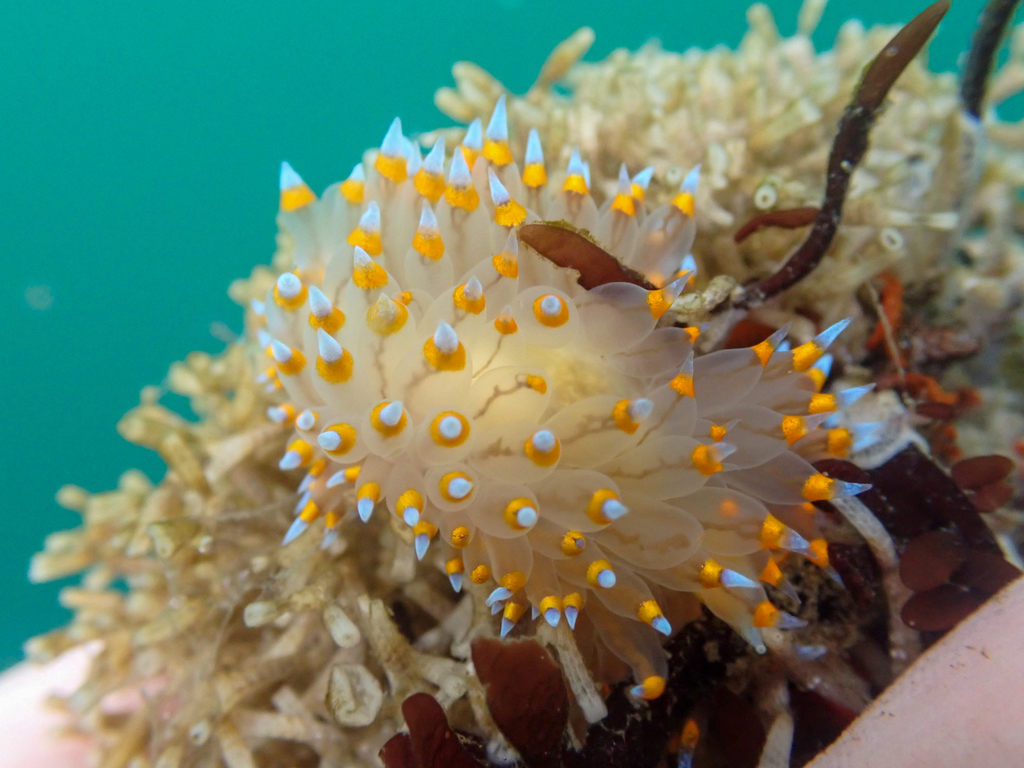






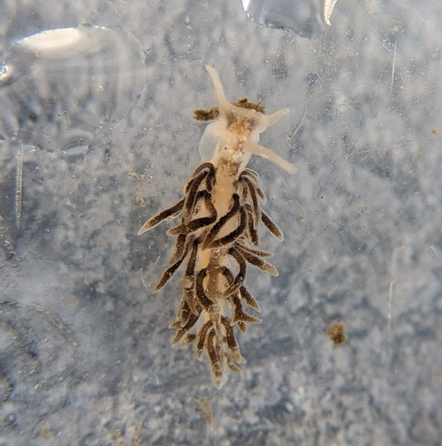



Hi Chloe , I love your photos ,your fun creative ways of describing these little but beautiful . Dock fouling looks like fun 😊❤️. I bet scuba diving would be fun for you and Trevor.
LikeLiked by 1 person
Thankies! I know! We really should try diving, but we both enjoy snorkeling enough in the tropics to satisfy us for now. But we should!
LikeLiked by 1 person
I forgot to add creatures after the word beautiful
LikeLiked by 1 person